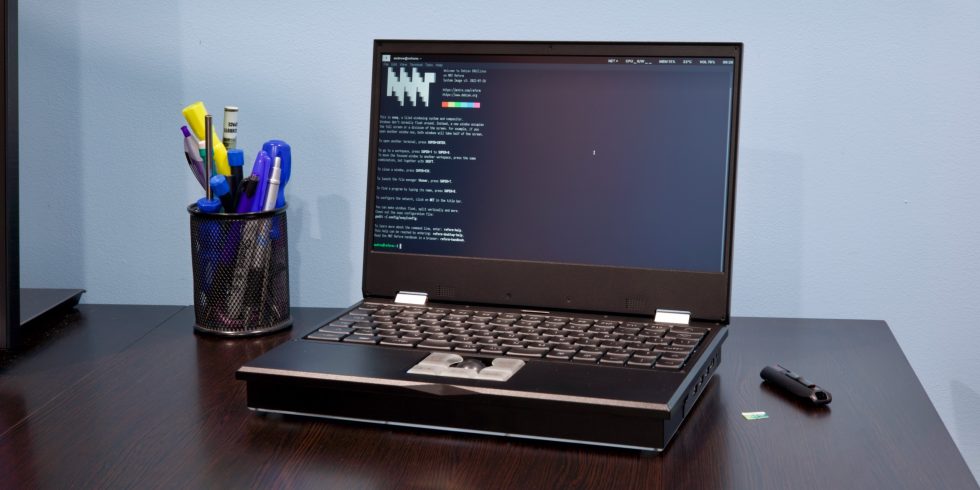
Enlarge / The MNT Reform, a boxy laptop built around maximally open-source hardware and software. (credit: Andrew Cunningham)
| Specs at a glance: MNT Reform | |
|---|---|
| Screen | 1920×1080 12.5-inch (176PPI) IPS screen |
| OS | Debian Linux |
| CPU | NXP/Freescale i.MX8MQ (1.5GHz quad-core ARM Cortex-A53) |
| RAM | 4GB |
| GPU | Vivante GC7000Lite |
| Storage | 32GB SD card, NVMe SSD optional |
| Networking | Optional 802.11n Wi-Fi, gigabit Ethernet |
| Ports | 3x USB-A 3.0, HDMI (optional), SD card slot |
| Camera | None |
| Size | 11.42×8.07×1.57 inches (290×205×40 mm) |
| Weight | 4.2 pounds (1.9 kg) |
| Battery | 8x 18650 LiFePO4 battery cells |
| Starting price | $1,358 (not assembled, with trackpad or trackball); $1,550 assembled with trackball |
If you’re a Linux fan or open source advocate looking for a decent laptop, you actually have some solid options right now—much better, at least, than buying a Windows laptop, installing Linux on it, and hoping for the best.
Dell has offered Ubuntu editions of some of its XPS laptops and other PCs for years now, and Lenovo sells a respectable collection of desktops and laptops with Linux. System76 sells a selection of Linux-friendly laptops preloaded with Ubuntu or its own Pop!_OS distribution. The repair-friendly Framework Laptop doesn’t ship with Linux, but it can be configured without an OS, and Framework promises robust Linux support from multiple distributions.
But those laptops all have something in common with run-of-the-mill Windows PCs: a reliance on closed-source hardware and, often, the proprietary software and drivers needed to make it function. For some people, this is a tolerable trade-off. You put up with the closed hardware because it performs well, and it supports the standard software, development tools, and APIs that keep the computing world spinning. For others, it’s anathema—if you can’t see the source code for these “binary blobs,” they are inherently untrustworthy and should be used sparingly or not at all.
Read 46 remaining paragraphs | Comments

Enlarge / The MNT Reform, a boxy laptop built around maximally open-source hardware and software. (credit: Andrew Cunningham)
| Specs at a glance: MNT Reform | |
|---|---|
| Screen | 1920×1080 12.5-inch (176PPI) IPS screen |
| OS | Debian Linux |
| CPU | NXP/Freescale i.MX8MQ (1.5GHz quad-core ARM Cortex-A53) |
| RAM | 4GB |
| GPU | Vivante GC7000Lite |
| Storage | 32GB SD card, NVMe SSD optional |
| Networking | Optional 802.11n Wi-Fi, gigabit Ethernet |
| Ports | 3x USB-A 3.0, HDMI (optional), SD card slot |
| Camera | None |
| Size | 11.42×8.07×1.57 inches (290×205×40 mm) |
| Weight | 4.2 pounds (1.9 kg) |
| Battery | 8x 18650 LiFePO4 battery cells |
| Starting price | $1,358 (not assembled, with trackpad or trackball); $1,550 assembled with trackball |
If you’re a Linux fan or open source advocate looking for a decent laptop, you actually have some solid options right now—much better, at least, than buying a Windows laptop, installing Linux on it, and hoping for the best.
Dell has offered Ubuntu editions of some of its XPS laptops and other PCs for years now, and Lenovo sells a respectable collection of desktops and laptops with Linux. System76 sells a selection of Linux-friendly laptops preloaded with Ubuntu or its own Pop!_OS distribution. The repair-friendly Framework Laptop doesn’t ship with Linux, but it can be configured without an OS, and Framework promises robust Linux support from multiple distributions.
But those laptops all have something in common with run-of-the-mill Windows PCs: a reliance on closed-source hardware and, often, the proprietary software and drivers needed to make it function. For some people, this is a tolerable trade-off. You put up with the closed hardware because it performs well, and it supports the standard software, development tools, and APIs that keep the computing world spinning. For others, it’s anathema—if you can’t see the source code for these “binary blobs,” they are inherently untrustworthy and should be used sparingly or not at all.
Read 46 remaining paragraphs | Comments
January 31, 2022 at 06:00PM

Post a Comment